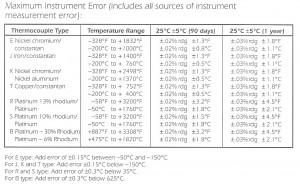53A-226 THERMOCOUPLE INPUT CARD
ORDERING INFORMATION
53A-226 – Thermocouple Input Card
OPT 1V-Add VXIbus Compatibility
• 10 input channels (expandable to 240 channels using 53A-339)
• Low cost
• Types J, K, R, S, T, 8, and E thermocouples can be intermixed
• Electronic cold junction compensation and linearization to degrees C or F
• Programmable set-points
• Can be operated as a micro-voltmeter
The 53A-226 Thermocouple Card provides 10 thermocouple input channels with ice point compensation and thermocouple linearity correction for types J, K. R. S, T. B. and E thermocouples. It makes temperature measurements at rates of up to fifteen readings per second (12.5 per second for 50 Hz operation).
The 53A-226 has three modes of operation:
– “Single Channel” Mode A channel number is selected under program control, and then readings taken from it.
– Scanning Mode A scan list is programmed and readings are sequentially taken from channels as defined by that list
– Limit Check Scanning Mode High and low set points are pre-programed for each channel. The on-card microprocessor then automatically scans and monitors each input channel for out-of-limit conditions. The 53A-226 may be programmed to generate an interrupt when a set point trip occurs freeing the system controller for other tasks.
Input channel may be added or deleted from the limit check scanning list, or high and low limits may be modified, without interrupting the limit check scanning. An override mode allows the user to temporarily track a channel of interest without disabling the limit check operation or any resulting interrupts generated as a result of an out-of-limit occurrence. Two methods of readback are available for an out-of-limit occurrence: the channel number only, or the channel number and measurement. The limit check mode also has a programmable scanning rate designed to prolong relay life in low-speed applications.
In all three modes. measurement readings returned in degrees Centigrade, Fahrenheit or Kelvin; or the 53A-226 Card may be programmed as a ten channel scanning micro-voltmeter with optional limit checking. Automatic updates of amplifier drift compensation and reference junction temperature are provided. If desired the automatic update feature may be disabled and the update performed under program control. The system controller can also read the 53A-226’s reference junction temperature, thus allowing the use of the Thermocouple Card as a temperature monitor in a 53/63 card cage.
Input voltage isolation of 200V dc is provided between the thermocouple inputs and system ground, and between any two inputs. The 53A-226’s resolution is 0.15°C(0.27°F) worst case resolution. and its total instrument accuracy is 0.8°C (1.3°F) ±0.02% of reading.
The 53A-226 determines the temperature of the thermocouple connected to the card by measuring a voltage that represents the difference between the temperature at the thermocouple sensor and the temperature at a reference junction. The temperature of the reference junction is compensated for through a process known as “ice-point compensation” because historically, the reference junction was placed in an ice bath at 0°C. Electronic ice point compensation is accomplished by an on-card microprocessor that measures the temperature of two high-accuracy thermistors located in close thermal proximity to the input screw terminals. The microprocessor also provides thermocouple curve linearity compensation that conforms to within 0.06°C of the Thermocouple Reference Tables published by NIST.
The screw terminals on the 53A-226 are completely enclosed in an isothermal chamber in order to maintain a minimum temperature difference between the input connections and the reference thermistor. Access to the screw terminals is provided through an easily removable rubber-seated cover plate which also provides strain relief for installed thermocouple wires. The screw terminal assembly is removable to allow easy installation of thermocouple wires and also to allow removal of the card for inspection or maintenance without disconnecting the cable-to-screw connections.
BITE
Visual Built-In-Test Equipment (“BITE”) is provided by a series of LEDs that indicate which thermocouple channel is presently selected, when an improper command is sent to the card, and when a calibration attempt was unsuccessful.
Specifications Types of Thermocouples:
J, K, R, S, T, B, and E.
Number of Channels:
Ten. Expandable to 240 with 10 53A-339 Thermocouple Scanner Cards.
Data Returned As:
ASCII Characters, base 10 decimal notation.
Modes:
Single Channel, Scan, and Limit Check Scan.
Functions:
Temperature: Centigrade, Fahrenheit or KeMn.
Voltage: – 13.9 to 76.5 mV range, – 0.7 to 21.2 mV range.
Input Configuration: Two wires plus shield for each channel isolated.
Voltage Mode Maximum Errors:
±0.02% rdg ±0.020 mV, 90 days (25°C ±5°C).
±0.03% rdg ±0.027 mV, 1 year (25°C ±5°C).
Input Protection:
250V dc or 250V RMS across input terminals.
Input Isolation:
±200V dc or peak ac between low and ground or any two channels.
Input Connections: 3 screw terminals per channel located within isothermal chamber. Access by removal of cover plate.
Reference Junction Compensation Accuracy:
±0.2°C from 0 to 50°C.
Common Mode Rejection:
120 dB at 50/60 Hz with 1 KOhm unbalance.
Normal Mode Rejection:
70 dB at 50/60 Hz.
Reading Rate*:
60 Hz, 15 readings/second (66.7 milliseconds/reading).
50 Hz, 12.5 readings/second (80 milliseconds/reading).
*Add additional 66.7 milliseconds for auto-range: add additional 200.0 milliseconds for null compensation and reference junction update.
Response Time: Latest reading available immediately.
Ranging:
Automatic between 0.57 µV resolution range and 2.4 µV resolution range.
Auto-ranging Levels:
Up-range at 100% of sensitive range.
Downrange at approximately 99% of sensitive range.
Calibration Cycle: 12 months.
Temperature Coefficient: ±(25 ppm ±2 µV)/°C.
Open Circuit Detection: Reading of 99,999 returned when open circuit condition is detected.
Resolution:
Voltage, 0.57 µV for-0.7 to 21.1 mV range; 2.4 µV for -13.9 to 76.5 mV range. Temperature, divide voltage resolution by voltage/degree gradient from the NIST Thermocouple Tables for the desired thermocouple type and temperature.
Available Option:
OPT 1V, add VXIbus compatibility.
